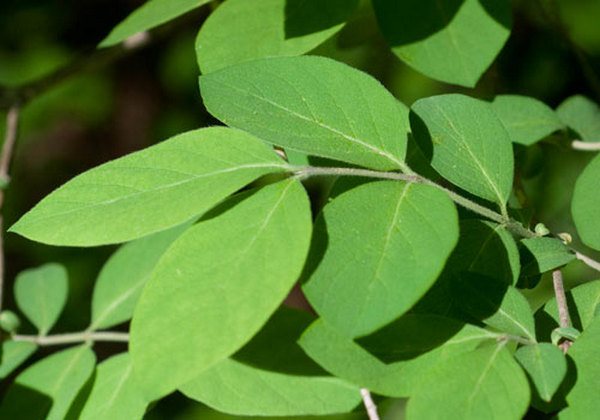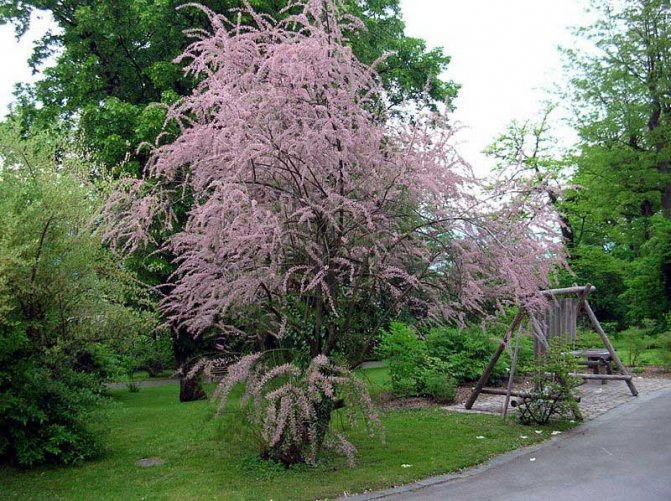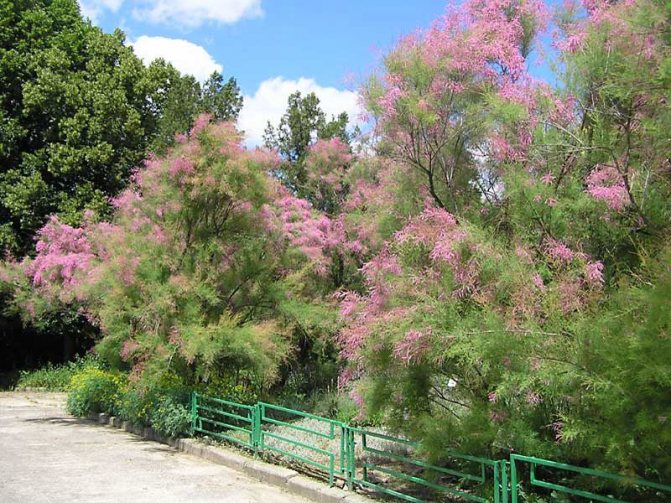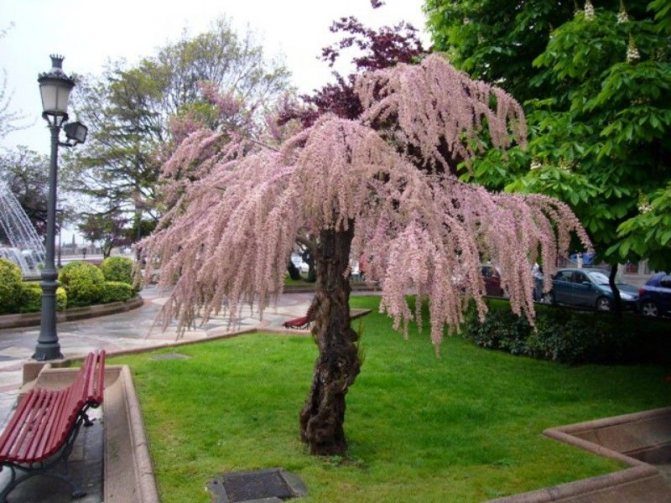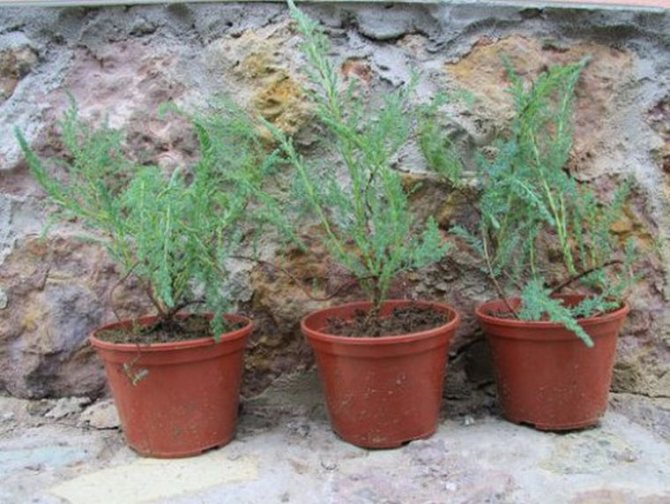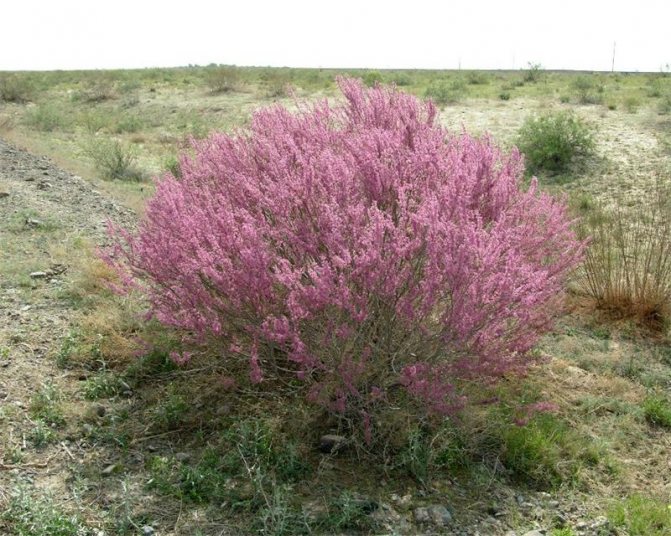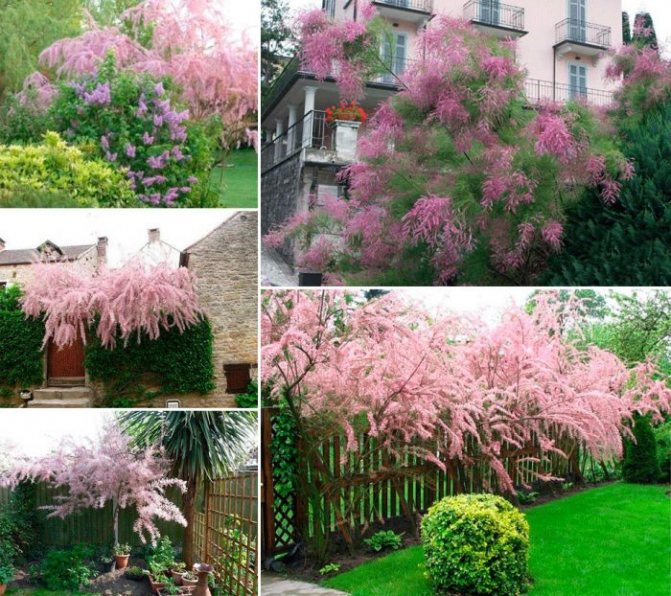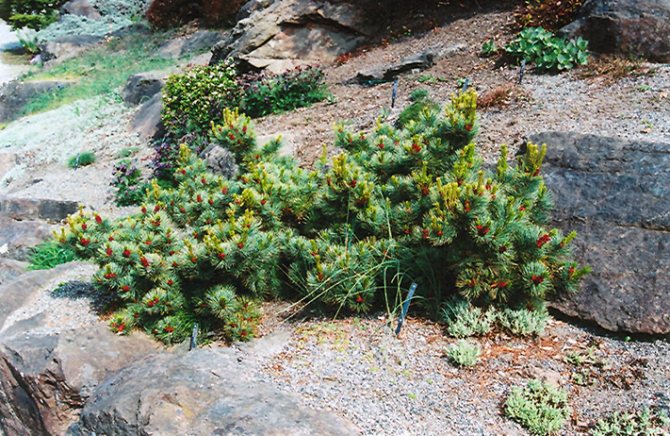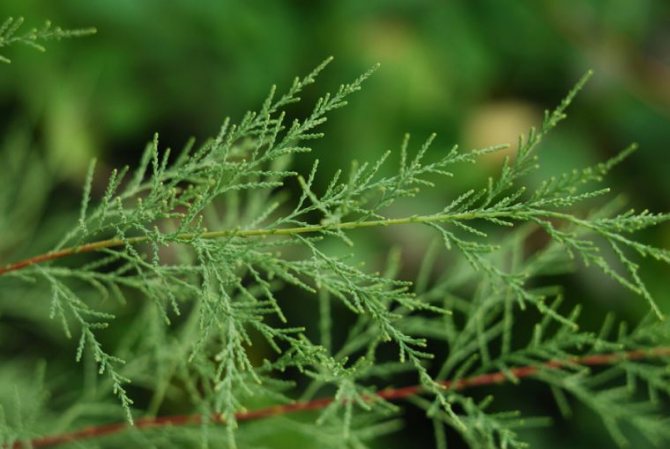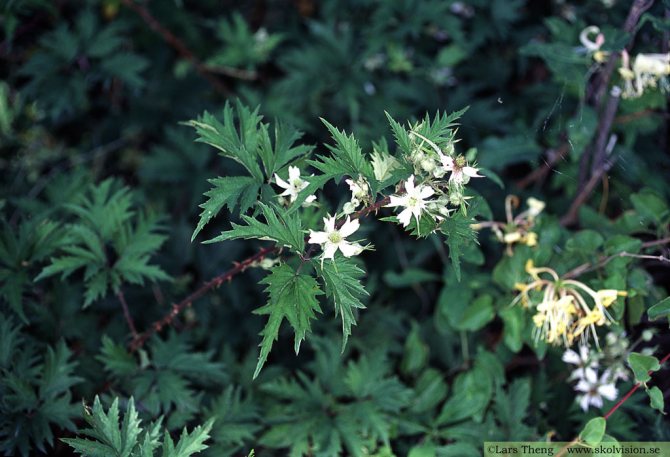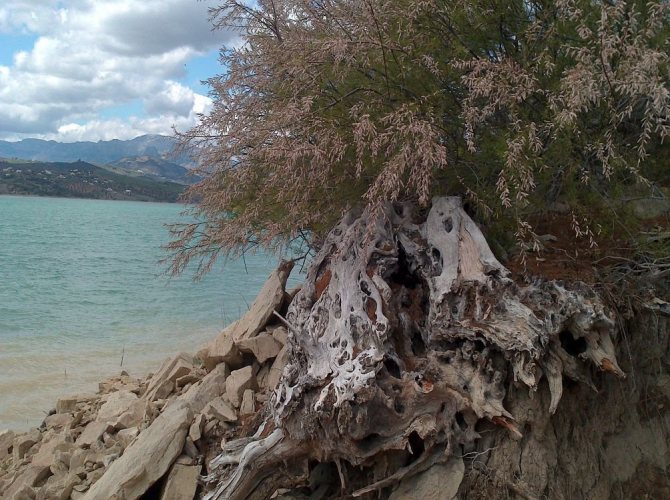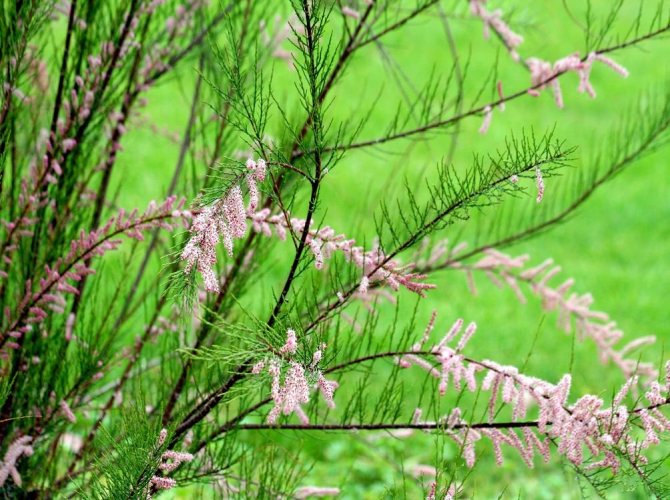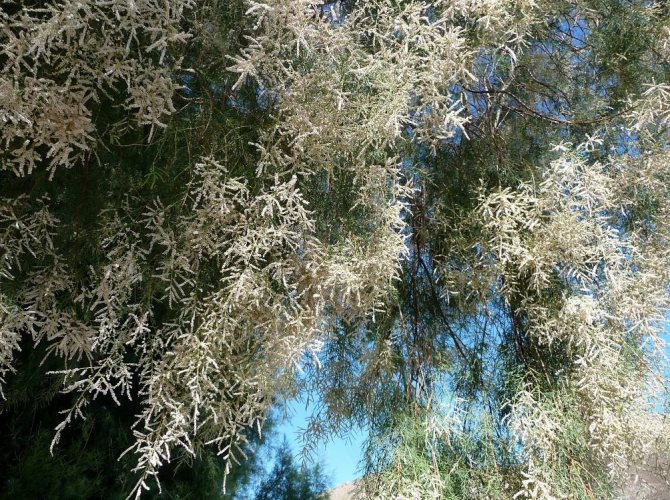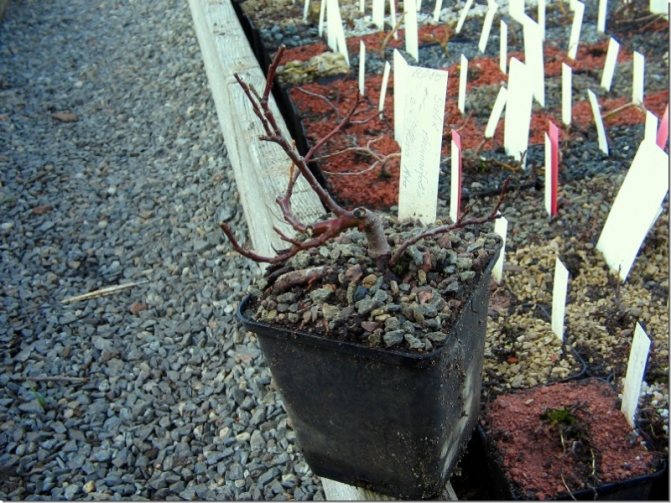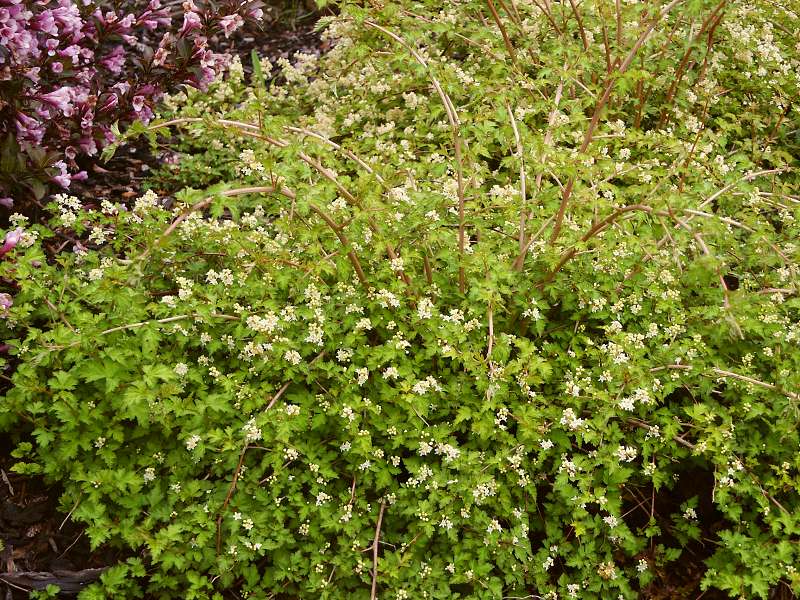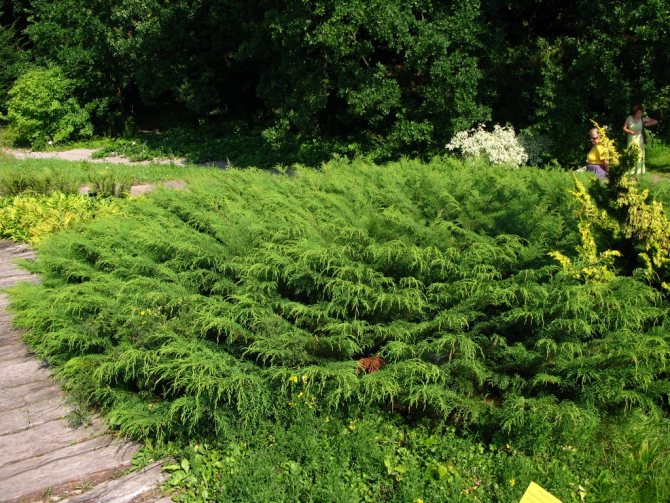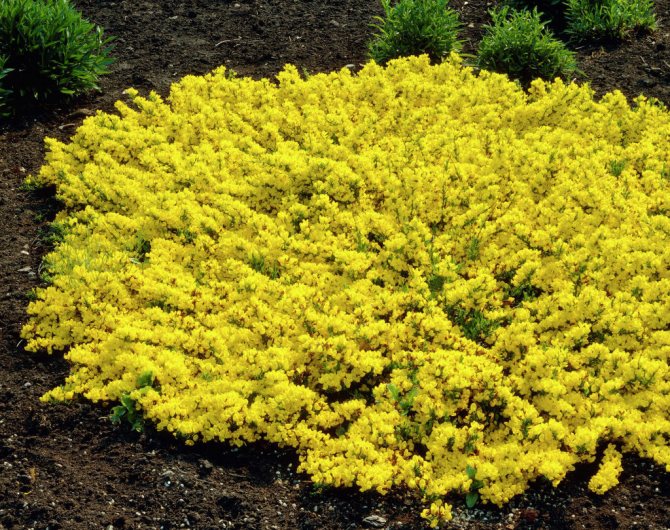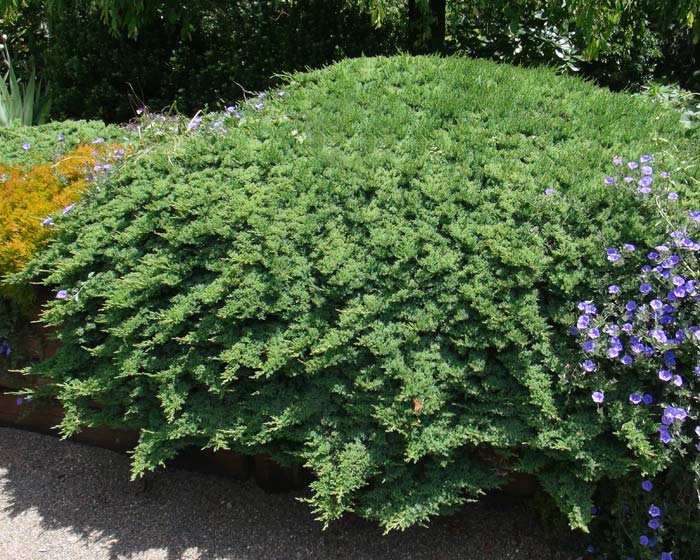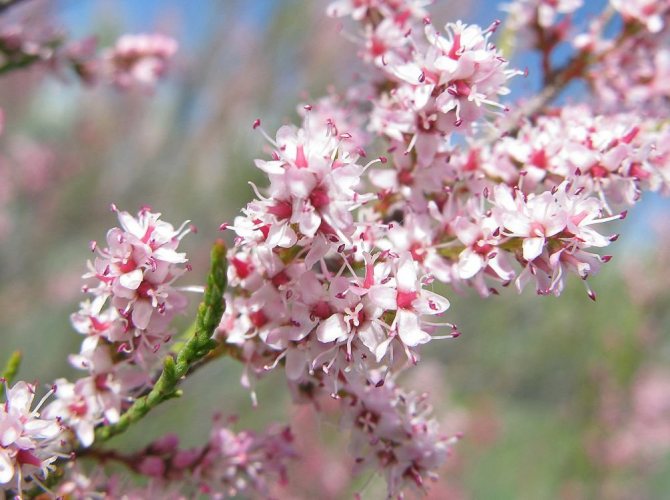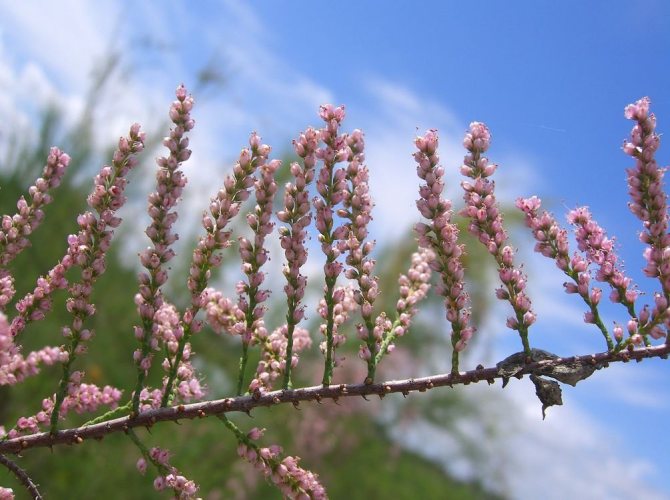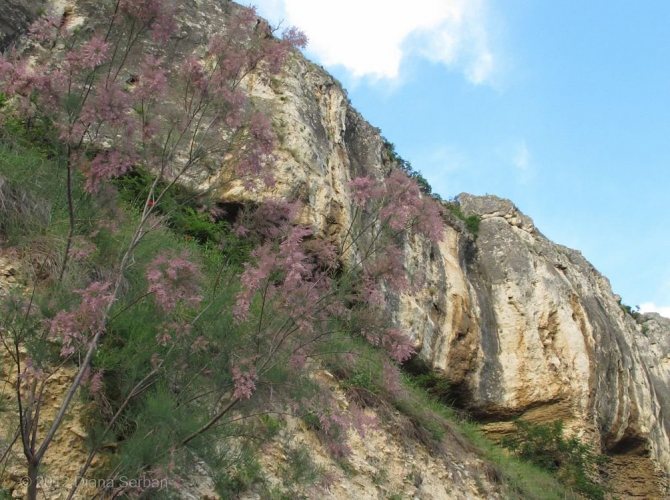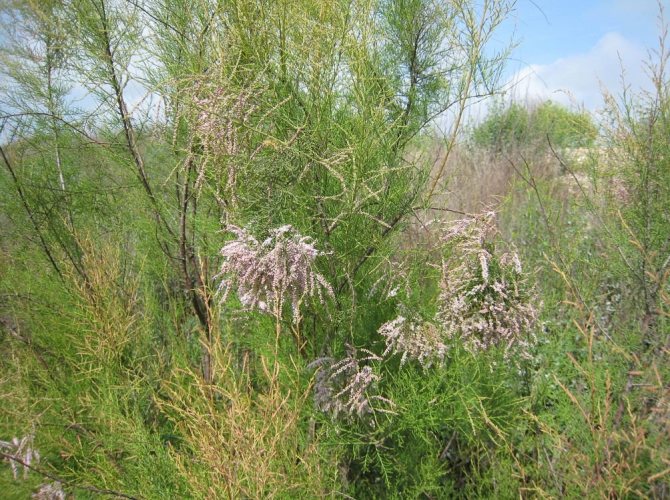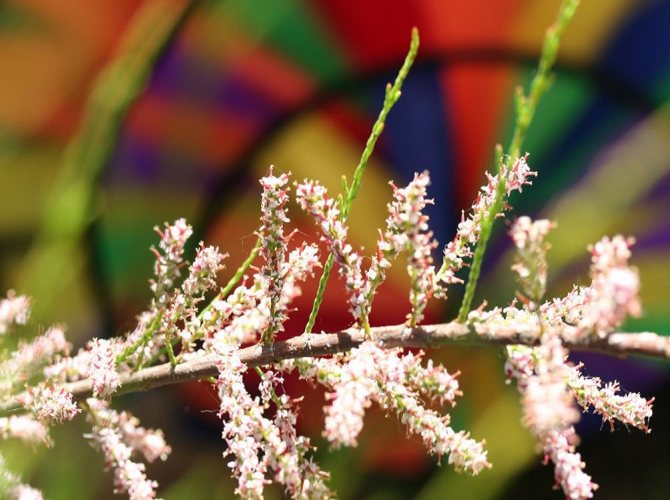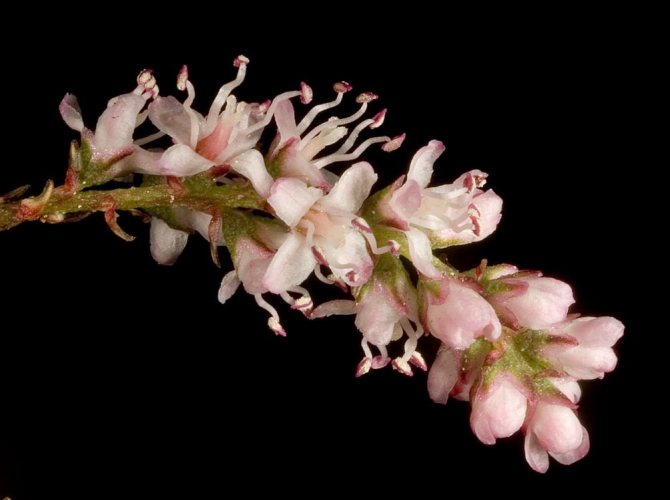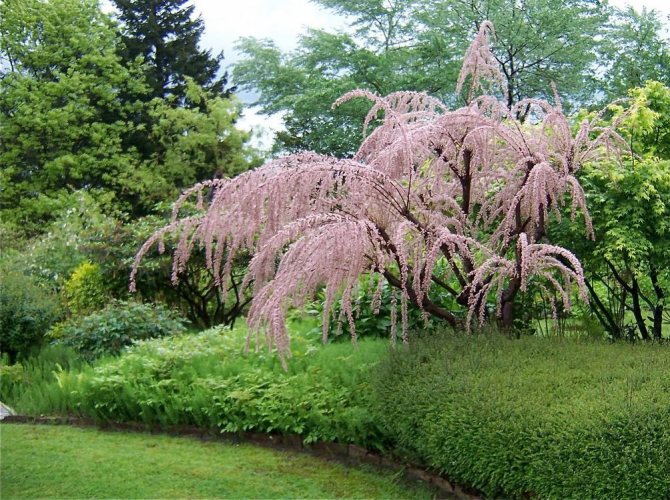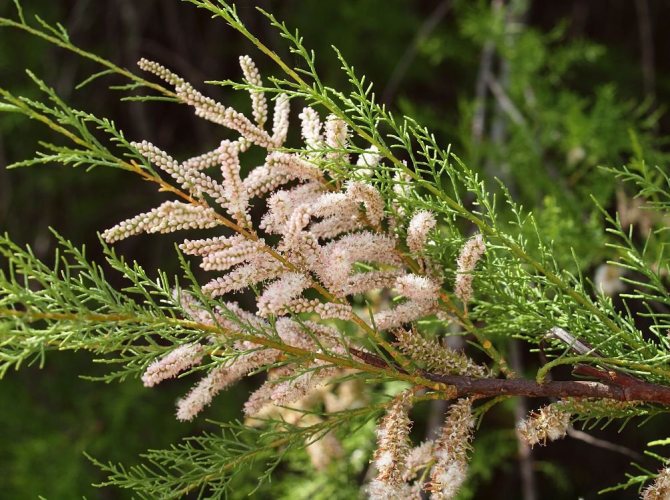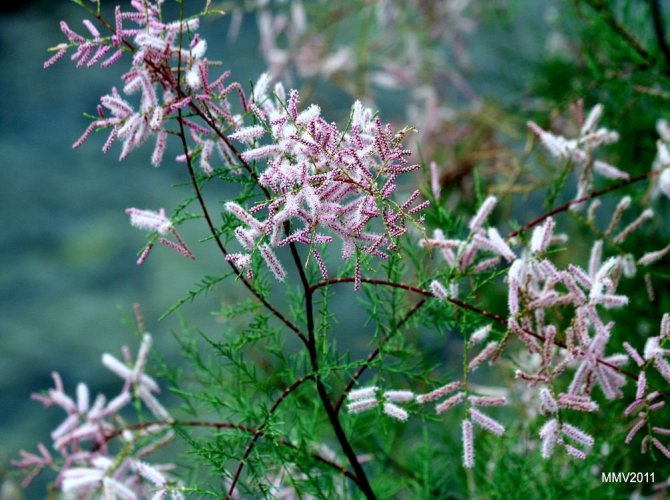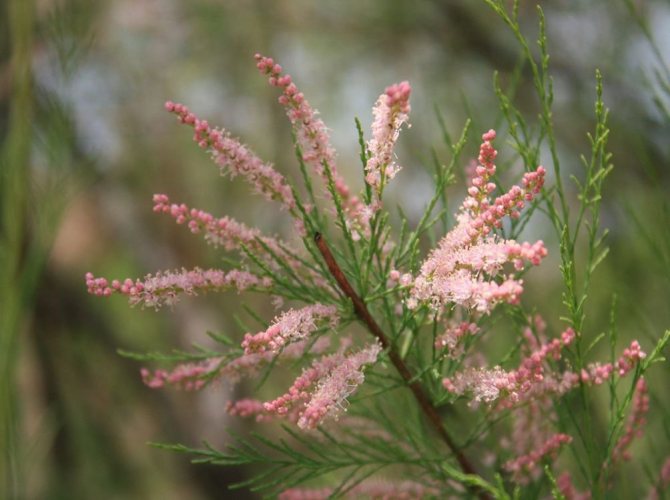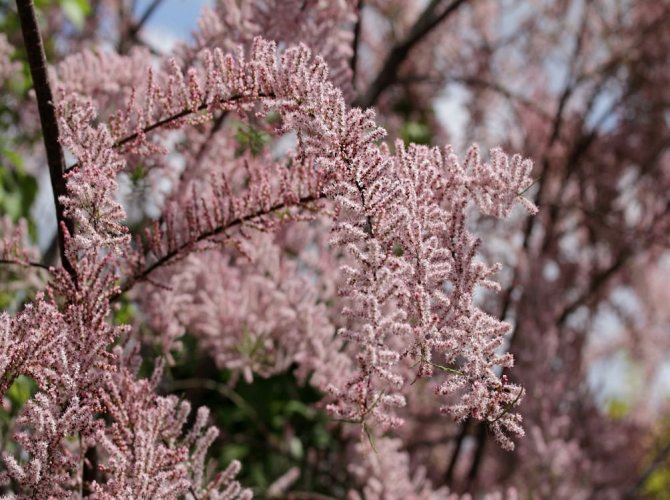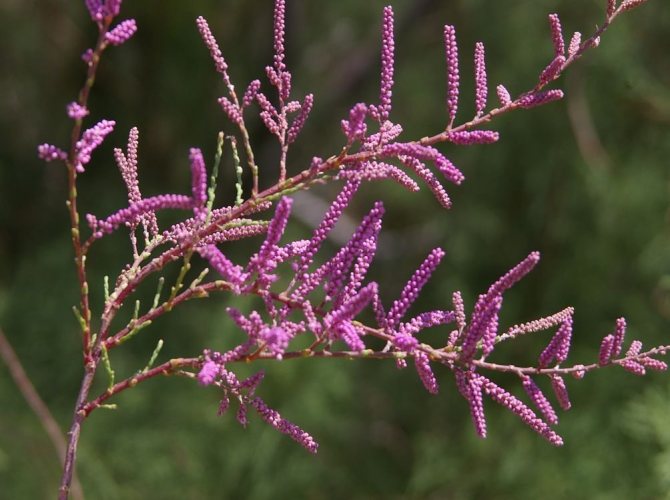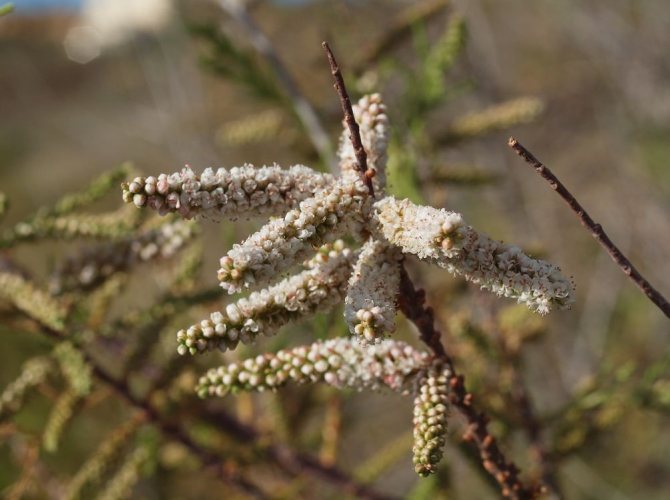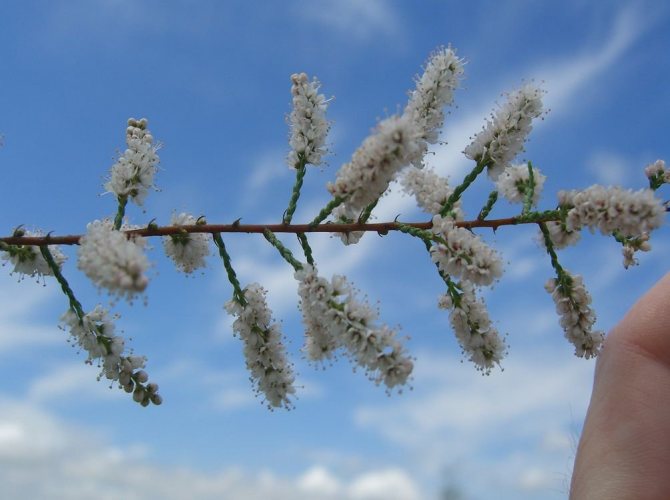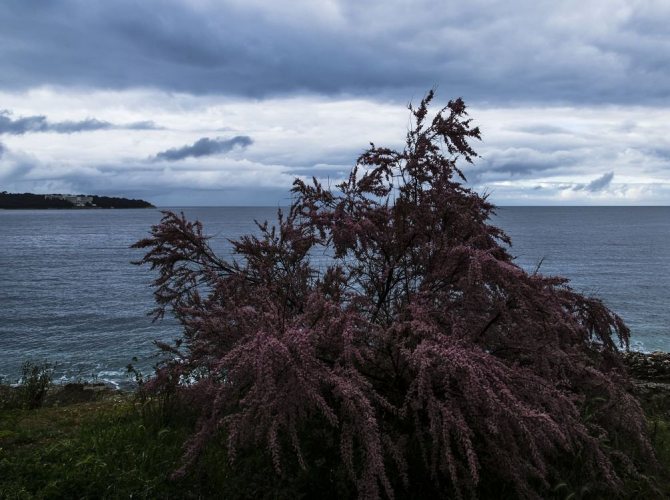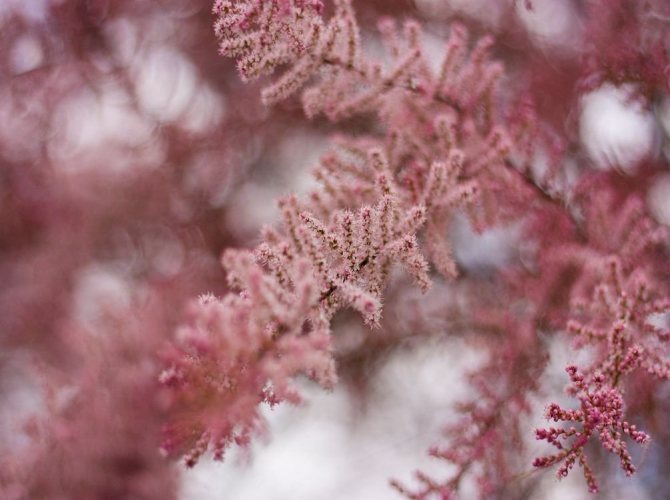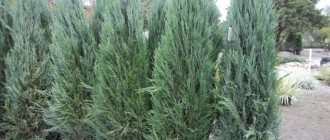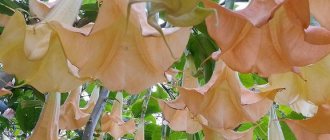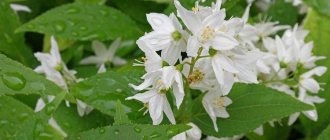Tamariks or comb, popularly called beads for bead buds, is an example of one of the most graceful shrubs. Its thin, flexible branches almost all summer and even part of autumn are completely covered with many small, pale pink or white, fragrant flowers. Tamarix, planting and caring for which does not create special problems for gardeners, is widespread from the gardens and parks of Western Europe to the eastern outskirts of Russia. To decorate your garden with this wonderful shrub, get acquainted with the peculiarities of its cultivation.
Features of the tamarix shrub
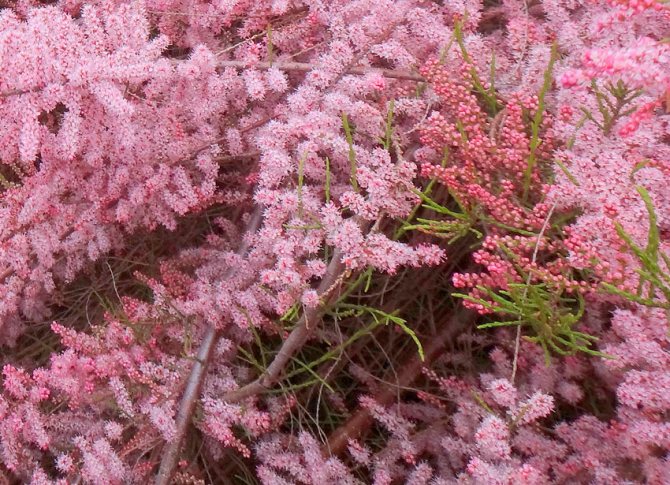
The graceful tamarisk shrub can be deciduous or evergreen. In addition to shrubs, trees are often found that grow bush-like, they have a height of 1.5-12 meters, and their trunk is not thicker than half a meter. The crown consists of rod-shaped stems, on which there is a huge number of alternately located small leaf plates similar to scales, their color can be emerald, greenish-blue or dark green. Large panicle or racemose inflorescences consist of small white or pink flowers. Before flowering, when the bush is strewn with many unopened buds, it may seem as if it was decorated with beads. This plant is an excellent honey plant, so during the flowering period it attracts bees to the garden. The fruit is a pentahedral-pyramidal box, which is polyspermous, inside it has small seeds.
Tamarisk is a very tenacious plant that is highly drought tolerant. This shrub can be grown even in a large city, because it is resistant to gas pollution. Growing such a plant is not troublesome and very pleasant.
Why is the plant attractive?
Bead is a very attractive plant that is often used in garden or plot decoration.
It gained popularity due to the fact that it has a lot of advantages, which we will look at below:
- it is a perennial plant, there is no need to worry about it every year, although it requires care;
- very beautiful shrub, will delight the eye of the owner and passers-by, guests;
- has healing properties;
- unpretentious Tamarix is a very diverse plant, there are many varieties of it;
- flowering time is very long;
- frost resistance;
- In addition to all the above benefits, the comb has the ability to adapt to different types of soil.
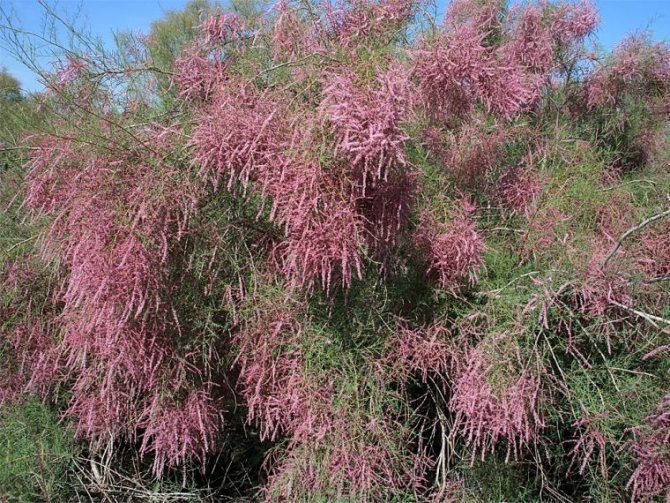

Planting tamarix in open ground
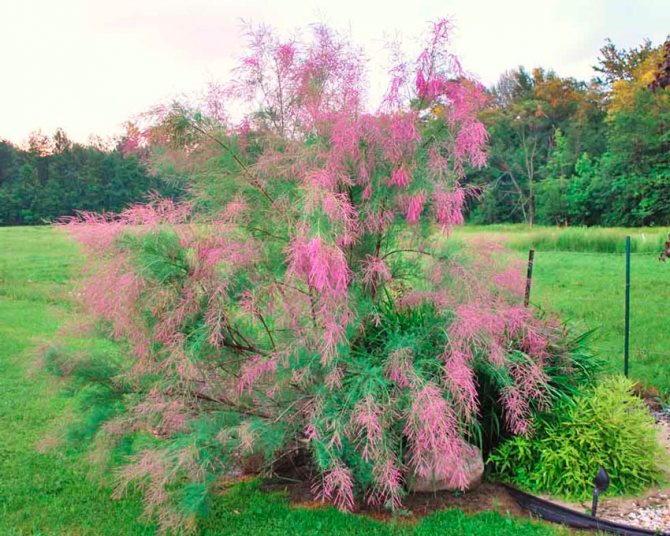

What time to plant
It is recommended to plant tamarix seedlings in open soil in the autumn during the fall of leaves, but it is better to do this at the very beginning of spring. The soil for such a shrub needs a well-drained one, while its composition can be of any kind. It can be grown even in heavy clay soil, but only in this case humus and peat must be added to the soil during planting. You can grow tamarisk in the shade, but it is better to choose a well-lit area for planting it.
The choice of a site for planting such a shrub must be done very carefully, because because of the long thin roots that are easy to damage, it suffers a rather painful transplant.
How to plant correctly
The size of the landing pit should be 0.6x0.6x0.6 meters.At the bottom of the finished pit, you need to make a good drainage layer, the thickness of which should be about 20 centimeters, for this you can use broken brick, crushed stone, expanded clay or pebbles. A mixture of humus and wood ash must be laid on top of the drainage. Then the pit should be filled with soil mixture by 2/3, which contains sand (1 part), fertile soil (2 parts) and peat (1 part).
Before planting, you should trim the stems of the seedling, while the remaining segments should not exceed 30-50 mm in length. Then the plant must be placed in a pit, which should be covered with soil mixture (the composition is described above), but only after the roots of the seedling are carefully straightened. Tamp the surface of the soil around the planted plant, and then water it well. When planting, it should be borne in mind that after the seedling is watered, its root collar should be at the level of the surface of the site.
Maintenance and pruning rules for the best result
Any landscape is suitable for Tamarix, but the location of groundwater should be at a level of 4 to 7 m. The decorative tree does not tolerate excessive moisture, therefore it grows well when watering 1-2 times a month. To complete the landscape design, young tamarix is often sheared, so the growth of the beads will accelerate. Enough 2-3 haircuts in the spring and summer season. Before preparing for winter, a standard sanitary pruning is carried out. In the northern regions, it is customary to cut off all flowering branches; otherwise, Tamarix can drop the excess on its own.
Caring for tamarisk in the garden
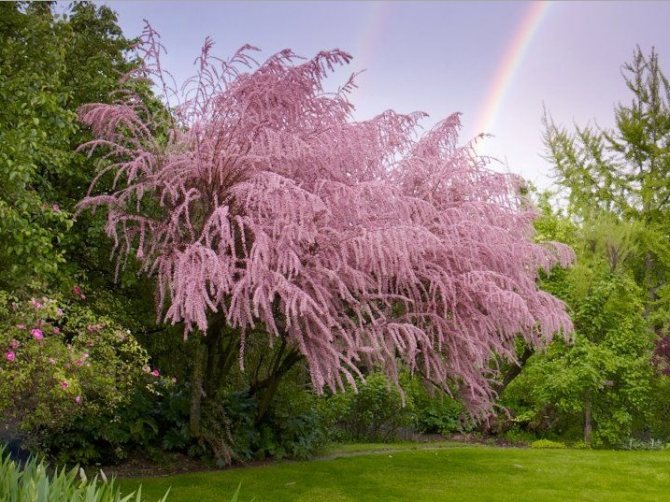

A tamarix seedling planted in open soil needs protection from direct sunlight and systematic watering during the first 15–20 days. After the leaves appear on the plant, they stop protecting it from the sun's rays, and also reduce the number of watering. In order for the water from the soil not to evaporate so quickly, its surface must be covered with a layer of mulch, for this you can use any organic material. Adult shrubs need watering only during a long dry period, but if it rains regularly in the summer, then there is no need to water the tamarix at all. After the rain has passed or watering has been carried out, you should slightly loosen the surface of the trunk circle, while pulling out all the weeds.
Top dressing of the bush is done in the spring, as soon as the growing season begins, for this they use organic fertilizer. In the summer, it should be sprayed over the foliage with a solution of phosphorus and potassium fertilizers.
Tamarix is highly winter-hardy, therefore it can be cultivated in regions with not very warm climates. So, in the Urals and in the Moscow region, this plant is today widespread quite widely. This shrub without shelter is able to withstand temperatures as low as minus 28 degrees. If the winters are very cold, then such a shrub simply needs shelter. To do this, the root zone should be covered with a thick layer of sawdust or covered with spruce branches, the trunk should be wrapped with a dense cloth or polymer film.
Pruning tamarix
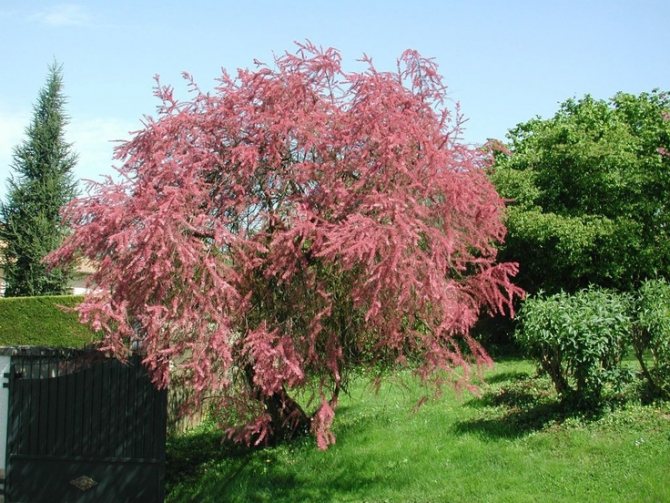

Tamarix needs shaping scraps, which he transfers easily enough. The best time to trim the crown is early spring, and you need to be in time before the buds swell. Old branches with short growths need to be cut into a ring, after only 4 weeks they will give young shoots, and the shrub will again become lush and beautiful. Such a plant needs rejuvenating pruning. They are made on a strong branch, which is placed as close to the base of the bush as possible. Remember that stem growth should not diminish as this will reduce the number and length of the inflorescences. With the beginning of the growing season, branches and stems damaged by frost can be identified, which will need to be trimmed to healthy wood.
You can also prune the shrub at the end of flowering. In order for the crown to remain spectacular and well-groomed, it is necessary to cut off excessively elongated stems, as well as inflorescences that have begun to fade. When pruning the shrub, try to make it more stable, otherwise its branches will need to be tied to supports.
In tamarisk, the crown thickens very quickly, in this regard, its thinning should be carried out systematically, cutting out part of the branches for this.
Diseases and pests
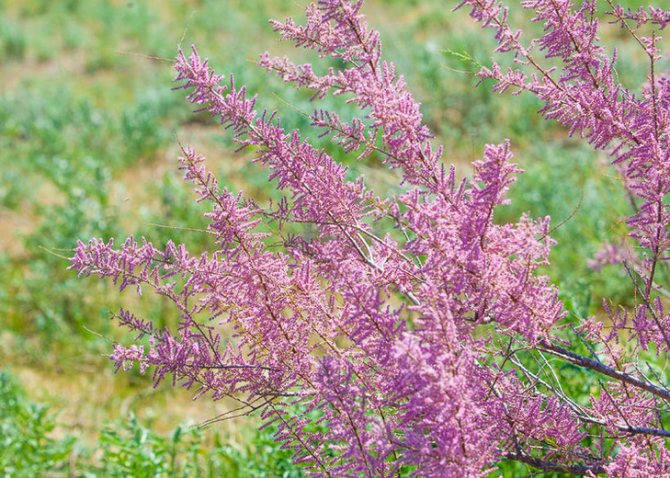

This shrub is highly resistant to pests. They can settle on it only if any of the neighboring plants is infected. To get rid of pests, it will be enough to spray the plant with an insecticide solution only once.
During the rainy season, tamarix can easily contract a fungal disease. Infected stems and branches should be cut and destroyed, and the bush itself and the soil around it should be sprayed with a fungicide solution.
Formation
Tamarix is pruned in early spring. If the treatment is carried out for sanitary purposes, then only old and damaged branches are removed. They can suffer as a result of mechanical stress and a sharp drop in temperature. Frozen parts must be removed.
Trimming is often done to form the correct symmetrical shape. In any case, the stems can only be shortened before the buds swell. If all recommendations are followed, the length and number of inflorescences will not change, and the bush will become more lush.
Tamarix can be pruned in the fall. Most often this is done to maintain a well-groomed and effective appearance. In the current circumstances, wilting inflorescences and stems that are excessively elongated are subjected to processing.
The result of the procedure is a more stable position of the plant. Thanks to this, you can avoid using supports. Through systematic pruning, they prevent the rapid thickening of the crown, accelerate the rejuvenation of adult bushes. In this case, the branches are removed at the root.
Reproduction of tamarix in the garden
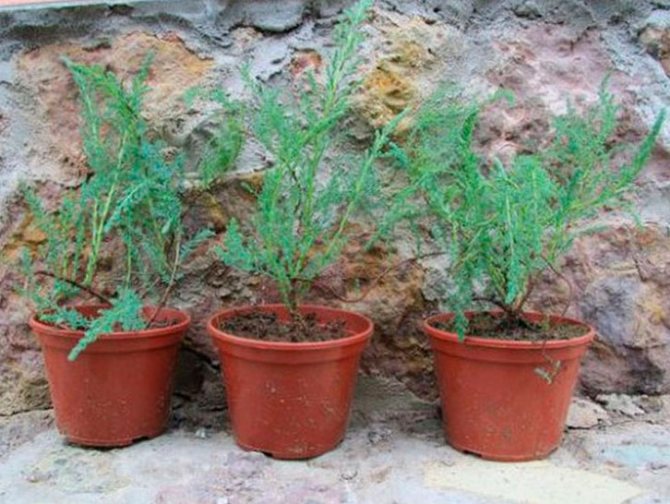

It is quite possible to grow tamarix from seeds, however, experienced gardeners do not advise spending their time on this, since cuttings are a more reliable and faster way of propagating such a plant.
You can propagate the shrub by cuttings at the beginning of the spring. To do this, you need to prepare semi-lignified cuttings 10 millimeters thick and 7-10 centimeters long. The lower cut should be treated with a solution of an agent that stimulates the growth of roots, then they should be planted at an angle in a container filled with a light soil mixture consisting of sand and garden soil (1: 1). It is imperative to put a dome on the top of the box, which must be transparent. Instead, you can cover each stalk with a glass jar on top. After the cuttings take root, young leaves will begin to grow. Such cuttings are planted in open soil in May, and do not forget that they need mandatory shelter for the winter. With the onset of the next spring period, the plants that have survived the winter can be transplanted to a permanent place.
You can resort to another method of rooting; for this, the cuttings are placed in a container filled with water. When roots appear on the cuttings, they will need to be planted in the garden and covered with glass jars.
When propagating tamarisk by the generative (seed) method, remember that its seeds retain good germination for a short time, and when growing a shrub in middle latitudes, they rarely ripen. There is no need to stratify the seeds before sowing. They are simply evenly distributed over the surface of the soil mixture, without deepening or sprinkling with earth. Then the container must be placed on a pallet that is filled with water. Strengthened and grown plants must be planted in school for growing. Seedlings need good shelter for the winter.After 1 or 2 years, the plant can be planted in a permanent place.
External features of the plant
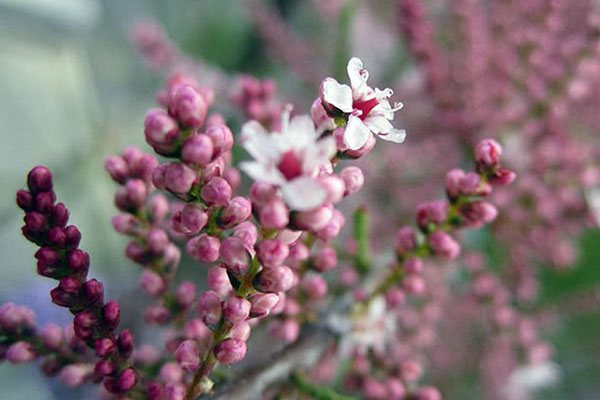

Tamarix is a deciduous or evergreen crop. Its crown consists of many twig-like stems, dotted with miniature foliage.
Depending on the type, the plates are painted in the following colors:
- bluish green;
- emerald;
- dark green.
In addition, the leaves have special glands that secrete "salt". Outwardly, they resemble needle-like needles, the length of which is about 6 mm. During the flowering period, the tamarix shrub is covered with small racemose buds. They come in white, pink, red or lilac. Before the panicles open, the buds resemble miniature beads that shine brightly in the sun. Since the plant is considered a honey plant, many bees flock to its elegant scent. Over time, pollinated inflorescences turn into poly-seeded pyramidal boxes. The culture wonderfully adapts to the polluted urban areas and is distinguished by its special vitality.
In nature, there are beads that reach 12 m in height. The trunk thickness of such trees is about 0.5 m.
Types and varieties of tamarix with photos and names
There are more than 70 species of tamarix in nature. However, most often cultivated are those that have high frost resistance.
Tamarix tetrandra
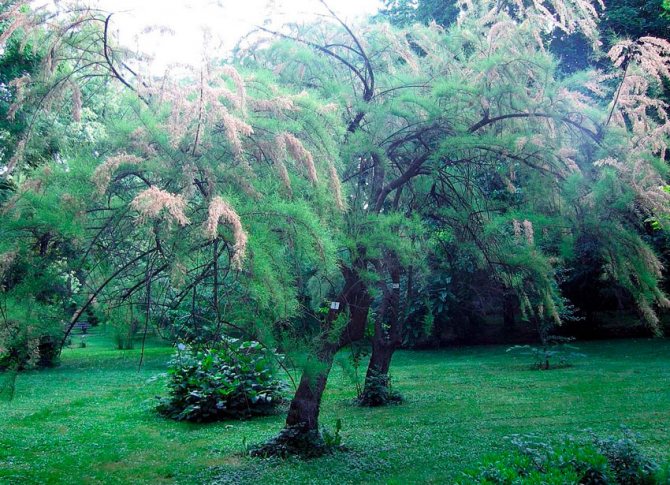

In nature, this species is found in Greece, Crimea, Asia Minor, as well as in the southeast of the European part of Russia. This shrub is relatively large and reaches a height of 5-10 meters. Arcuate curved branches are painted red-brown. Green-emerald leaf plates have an ovate-lanceolate or lanceolate shape, they taper towards the base, and at their top there is a beak-shaped sharpening. On the lateral shoots are racemose inflorescences, consisting of flowers, painted in various shades from pale pink to white. The plant blooms in April or May. This shrub is drought tolerant and durable (it can live for about 75 years).
Loose tamarix (Tamarix laxa)
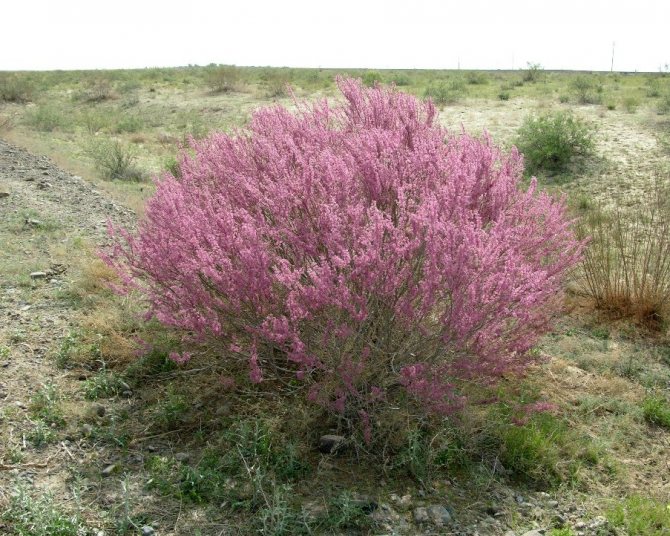

Under natural conditions, such a plant is found in northwestern China, northern Iran, Mongolia, Afghanistan and in the lower reaches of the Volga. This species is represented by a large branched shrub or a medium-sized tree, its height is about 5 meters. Bare spreading branches are colored gray or green. Directly spaced leaf plates of an oval-rhombic or ovoid shape taper towards the base and sharpen towards the apex. The apical panicles are formed by lush racemose inflorescences consisting of pink flowers. This plant blooms for about 8 weeks. This species is distinguished by its drought and frost resistance, it is not picky about the soil and normally tolerates its salinity.
Tamarix graceful (Tamarix gracilis)
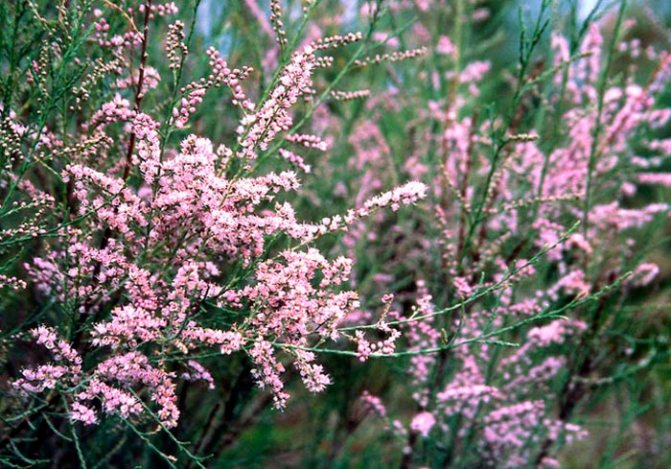

In natural conditions, such a tamarisk is found in China, Ukraine, Kazakhstan, Siberia, in the west of Mongolia and in the south of the European part of Russia. The shrub height does not exceed 4 meters. On the surface of thick, concatenated branches, there are pale fawn specks of cork in the leaf axils and along the shoot. The color of the bark is greenish gray or chestnut brown. Pointed leaf plates on green shoots are tiled. On one-year-old branches, leaf plates of larger size grow, and they have a lanceolate shape and a fawn color. Simple spring racemose inflorescences are about 50 mm long and consist of deep pink flowers. Summer flower clusters are part of large paniculate inflorescences, and they reach 70 mm in length. This type is frost-resistant and beautifully flowering, it is often used by landscape designers.
Branched tamarix (Tamarix ramosissima), or five-lined tamarix (Tamarix pentandra)
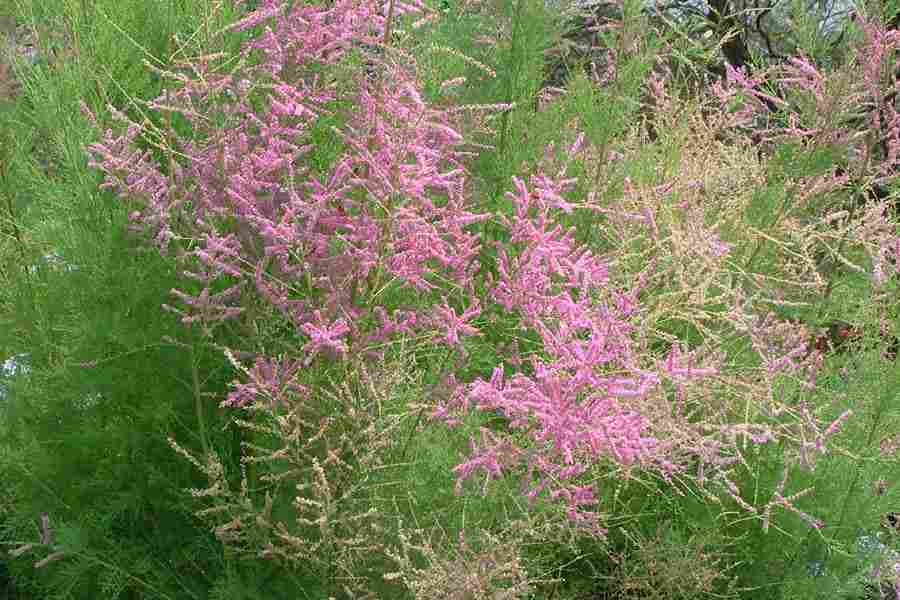

In the wild, such a plant can be found in Iran, Mongolia, Moldova, China, Central Asia, Ukraine and the Balkans. It prefers to grow on river banks, pebble shoals and on the terraces of river valleys. The height of such an upright shrub is about 2 meters. Thin branches are light gray or pale green, and annual shoots are pale red. Narrow awl-shaped leaf plates have curved tips. Dense complex racemose inflorescences reach 50 mm in length, they consist of pink flowers. Flowering is observed in June – September. Such a shrub is not picky about the composition of the soil, it quickly adapts to the conditions of the city, after freezing it is easily restored, but it must be covered for the winter. Popular varieties:
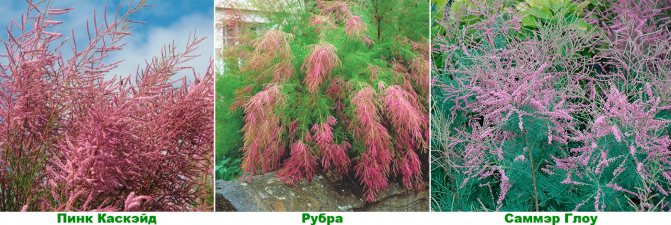

- Pink Cascade... This variety blooms very luxuriantly.
- Rubra... The color of the flowers is red-violet.
- Summare Glow... The color of the flowers is rich crimson.
What does tamarix look like?
A detailed description of the tamarix shrub will help distinguish it from other trees. The main distribution area is the Mediterranean and Central Asian countries. Wild bushes can be found in Crimea. On the territory of the desert, the comb grows up to 8 m in height, and its diameter is 1 m. The bush is called a bead bush because in spring small buds resembling beads appear on it. At this time, the bush is very beautiful and decorated.
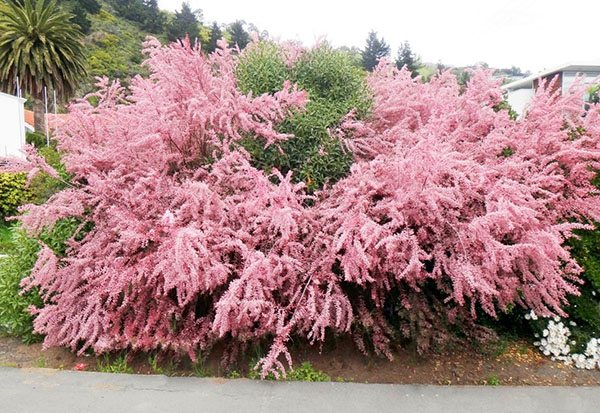

According to the description, the tamarix shrub (pictured) is presented as a small tree. It has alternating scaly leaves and miniature shoots. The bush blooms with pink or purple inflorescences.
Tamarix is described as a resistant plant that does not require much effort to care for. He likes the light, but the bush can grow normally in the shade. The tree adapts to any type of soil, easily withstands high temperatures and dry periods. The tamarix shrub can be trimmed and used to form hedges.
Tamarisk in landscape design
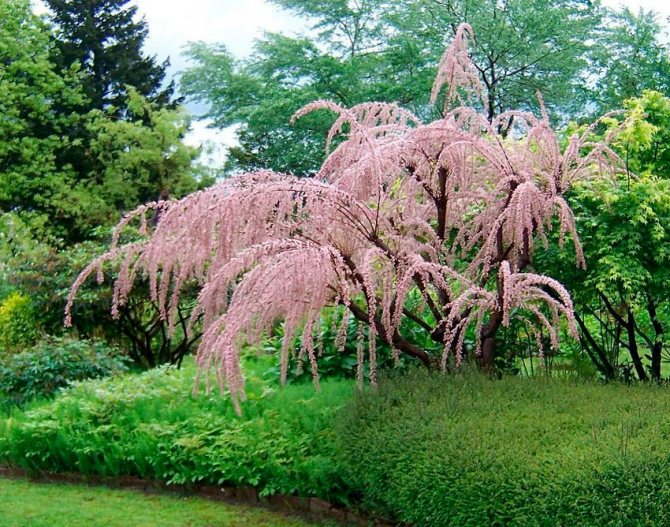

Tamarisk is used in landscaping for group compositions and trimmed hedges. This plant is also used as a tapeworm, for example, as a flowering "fountain" in the center of a green lawn. Not very tall trees and shrubs of this genus are recommended to be combined with conifers, namely: thuja, juniper and dwarf spruce. Also, this plant is in harmony with lilac, barberry and jasmine.
Certain evergreen tamarisk species are cultivated at home. Tamarix is also grown on saline soils, in forest plantations, in deserts and semi-deserts, and is also used to fix moving sands and slipping banks.
Diseases and pests
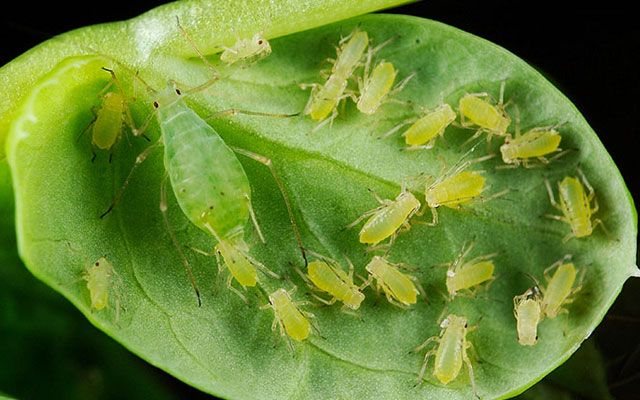

Tamarix is very rarely sick. Pest insects rarely eat its leaves. Despite this, you need to know the necessary preventive measures and methods of treatment.
Diseases occur most often due to improper care. This is especially true for abundant watering. Stagnant soil can cause disease. The root system starts to rot. In some cases, the flower dies, so prevention consists in proper care.
A symptom of a fungus that appears from excessive moisture is brown spots on all parts of the shrub. All affected branches should be cut and burned immediately. After that, the bush is thinned out.
For pests, such as aphids and ticks, there are special preparations that can be bought at the garden store. They are used exactly according to the instructions. People fight insects with a solution of laundry or tar soap. The whole plant is sprayed with it.
The healing properties of the tamarisk bush
The shrub has not only decorative but also medicinal properties. Its leaves, bark and flowers contain valuable substances - tannins, tannins, polyphenols and vitamins.
Thanks to this, tamarix is used for the preparation of decoctions, infusions and tinctures on alcohol. Medicines:
- have a diuretic effect;
- help to lower the temperature;
- astringent and helps with diarrhea and nausea;
- allow you to quickly stop the blood and have an analgesic effect;
- relieve inflammation and pain in rheumatic ailments.
It is customary to harvest the medicinal raw materials of tamarix at the beginning of summer, at a time when the leaves and shoots of the plant contain the maximum amount of valuable substances.
Reproduction methods
Seeds
Seed germination is maintained for 4 months after ripening, therefore, only fresh seeds are used for sowing:
- fill the container (in the bottom of which there are drainage holes) with a mixture of sand and fertile soil;
- seed material is embedded to a depth of 1 cm at a distance of 3-4 cm from each other;
- when the sprouts reach a height of 3-4 cm, they dive into separate cups;
- 2 years seedlings grow at moderate humidity and room temperature;
- in spring and summer, plants are taken out into the street, in winter they are brought into the room;
- in a permanent place, a shrub together with an earthen lump is planted in the spring, in the 3rd year of the growing season.
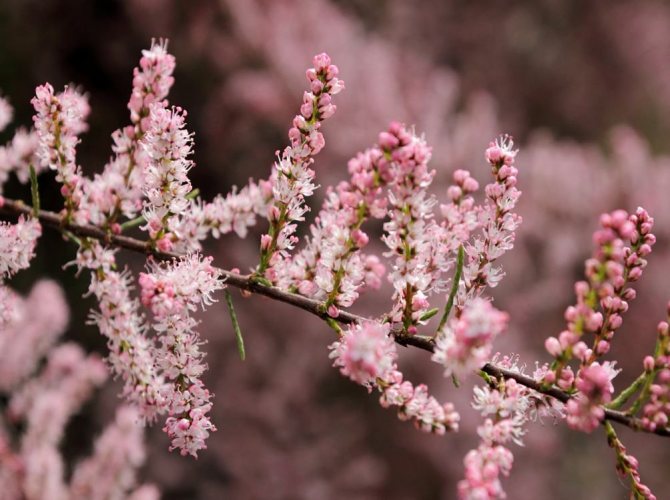

Cuttings
Cuttings need to be prepared in the fall, from young (1-, 2-year-old) lignified branches, the length of which should be 10-15 cm.The cuttings are placed in water and kept until roots appear, then planted in a sandy-peat substrate, covered with a film and transferred in a warm, well-lit place. In May-June, they are transplanted to a permanent place.
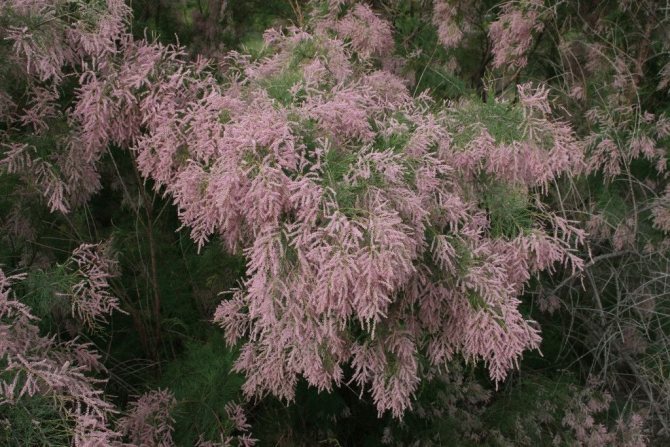

Preparing tamarix for winter
Despite its resistance to cold weather, tamarix needs additional shelter.
If the temperature in the region drops to -25 ° C, it is necessary to cover the culture with one of the following materials:
- sackcloth;
- polyethylene film;
- cardboard;
- sawdust.
The near-trunk area is covered with spruce branches, which are prepared in advance. In some cases, the branches may be damaged. However, in spring they should be pruned to give the green light to young shoots.
Garden, vegetable garden and flower garden tips
The waning moon in August 2019 when from what date to what date
Moon phases in August 2019 by day for gardeners and truck farmers
The growing moon in August 2019 when from what date
Flowering period of tamarix
The flowering time of tamarix depends on the variety - some bloom earlier, some later. On average, flowers begin to bloom in April and can delight the eye right up to September. To achieve this effect, it makes sense to plant different types of shrubs on the site.
Tamarix is famous for its flowers - delicate and very fragile inflorescences grow on a short peduncle. They are collected in racemose bunches. Tamarix looks spectacular even when the flowers have not yet blossomed - the buds look like beads that are glued to the branches. Because of this, the shrub is often also called a beaded shrub.
Gardeners reviews
Strawberry month
The trick is that it blooms at the end of summer on new shoots. Therefore, the "skeleton" of the bush hibernates. And in the spring, new branches of a beautiful shape and color begin to grow. And already on them buds appear, like beads.
Olga
I saw a young bush with friends, more than a meter in height, woody shoots, on them like a thuja needles of a gray color, green-bluish, and at the ends of the shoots blooms with pink long inflorescences, like candles. They are made from a variety of fluffy pink flowers and smell like honey.
What a flower "tamarix"
Tamariks is a small tree-type shrub from the Tamariks family of the same name. It has thin arcuate branches with reddish-brown bark, it can reach a height of 4 m and more, but most often it grows only up to 1.5 m. In spring, tamarix shoots are covered with racemose inflorescences with flowers of white, pale pink and pale lilac. The leaves of tamarix are lanceolate, bluish-green, the crown is spreading and very light and delicate.
In total, there are more than 70 plant species, but in Russia, planting and caring for the four-stalked tamarix and several other varieties are most often considered.
Winter hardiness of tamarix
In general, the frost resistance of tamariks, or beads, is considered very high. Some species can withstand temperatures as low as -50 ° C, although in this case the plant will need shelter. Any of the plant species can easily tolerate a drop in temperature to - 17-20 ° C, for this reason, the shrub is actively grown even in the northern regions of the country.
How and when tamarix blooms
The specific timing of flowering depends on the type of shrub. But on average, flowering occurs in April or May. A unique feature of tamarix is the ability to bloom up to 3 times per season, the inflorescences on the bush can also bloom in mid-summer and early autumn.
The inflorescences of tamarix are long, up to 15 cm in each cluster, and they consist of small flowers of a white or pale pink hue. The buds, which have not bloomed to the end, slightly resemble large beads, hence the second name of tamarix. Blooming beads are a bit like lilacs, but their crown is more delicate and spreading, and the clusters of inflorescences are thinner and longer.
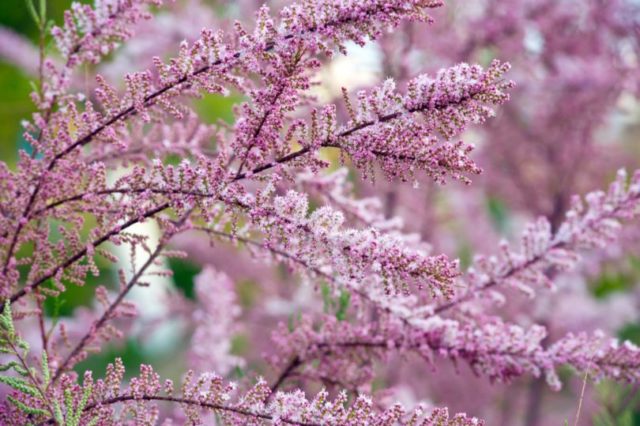

How fast is tamarix growing
Bisernik belongs to shrubs with very fast growth, not least of all this is due to its popularity in landscape design. For a year, tamarix can give an increase of up to 1 m. The roots of the shrub also grow very quickly, they can reach a meter in length even when the height of the plant itself does not exceed a few centimeters.
Advice! Photos of growing and caring for tamarix indicate that it is very convenient to use it in artistic compositions. You do not have to wait for the result for a long time, tamarix very quickly acquires the required dimensions and enters into full decorativeness.
Growing tamarix from seeds
The seeds can be planted within 4 months after climbing, so it is better to plant tamarix immediately. To do this, the following points should be observed:
- Prepare a container with suitable loose soil and add plenty of sand. Remember to make holes in the bottom of the pot.
- Tamp the seed shallowly, up to 1 cm above the surface. Sow as little as possible, so as not to loosen later: the distance between the seeds is at least 3-4 cm.
- When the seedlings are 5–6 cm tall, plant them in separate containers, pots.
- It takes about 2 years to grow a tree. It is necessary to monitor the conditions: the temperature should be average, room temperature, no more than +25 degrees. And also maintain a moderate humidity of 50–70%.
- In spring and summer, seedlings need open space, so it is better to take them out of the house. In winter, remember to return the plants to warmth.
- You can transplant tamarix in the spring, when he will be 2 years old. It must be placed in the soil with the soil in which it was grown before transplanting.
Origin
Tamarix shrub is distinguished by an extensive palette of shades, to many it resembles bead decorations, therefore another name for the plant is Beadnik.
The name of the plant speaks of its origin - it was first discovered near the Tamariz River, located in the Pyrenees (the modern name of the river is Timbra). At least 75 of its species are known in the world, which grow over a vast territory from southern Europe to India.
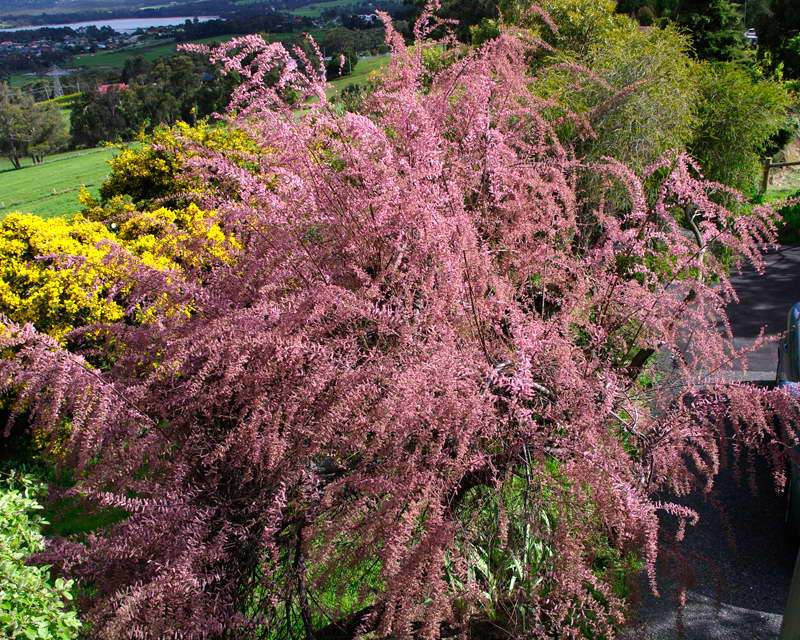

Tamarix is an amazingly beautiful and unpretentious shrub
Possible problems
Tamarix is unpretentious, you need to provide him with simple conditions of detention:
- so that root rot does not appear, the plant should not be excessively moist;
- to prevent the appearance of mold, you need to regularly prune, prevent thickening of the shrub;
- for the winter, tamarix is wrapped in burlap, foil, cardboard, and the trunk circle is covered with spruce branches and wood chips.
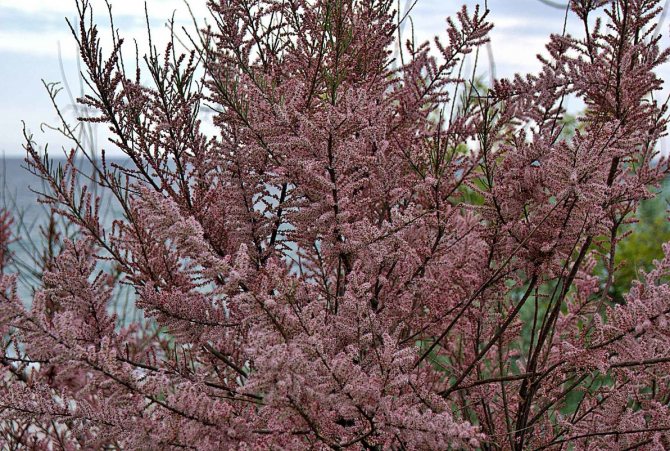

Botanical characteristics
Tamarix is a perennial evergreen or deciduous plant with powerful roots.Like a thick liana, they rush underground in different directions in search of water and nutrients. The average plant height is 3-5 m, sometimes trees up to 12 m in height are found. The form of vegetation is tree-like or shrubby. The trunk diameter does not exceed 50 cm. A lot of thin processes are formed from the main shoot and lateral skeletal branches.
The leaves, resembling small scales, are 1-7 mm long. They are colored dark green, emerald green or bluish green and fit tightly to the stem. Saline glands are present on the foliage.
The flowering period for different species of tamarix occurs at different times. The first flowers appear in May at the four-stalked tamarix. The last to bloom in August-September is loose tamarix. Flowers on very short pedicels are collected in paniculate or racemose inflorescences on the shoots of 1-2 years of life. Even unblown buds are highly decorative. Like the smallest beads of pastel colors, they stick around the branches.
Bisexual flowers 1.5-5 mm long consist of ovoid or linear bracts with a blunt edge. Under them are 4-7 rounded petals, painted in pink, purple, scarlet or white. In the center there are 4-6 filiform stamens thickened at the base with cordate anthers and an oblong ovary with a trihedral column.
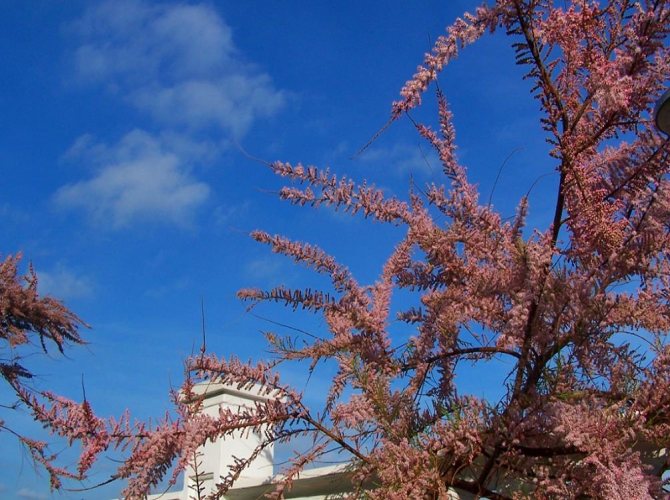

After pollination, the branches are covered with small fruits - polyhedral pyramidal capsules with many seeds. Each seed has a tuft. After ripening, the pods open, and the wind carries the smallest seeds over long distances.

